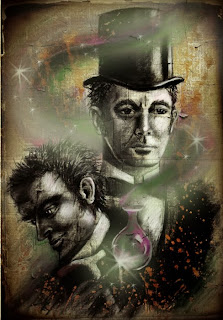"With every day, and from both sides of my intelligence, the moral and the intellectual, I thus drew steadily nearer to that truth by whose partial discovery I have been doomed to such a dreadful shipwreck: that man is not truly one, but truly two. I say two, because the state of my own knowledge does not pass beyond that point. Other will follow; others will outstrip me on the same lines; I hazard the guess that man will be ultimately known for a mere policy of multifarious, incongruous and independent denizens. It was on the moral side, and in my own person, that I learned to recognise the thorough and primitive duality of man; I saw that, of the two natures that contend in the field of my consciousness, even if I could be rightly said to be either, it was only because I was radically both" ("Henry Jekyll's Full Statement of the Case").
A quote on this issue from G.K. Chesterton (scholar, critic, and theologian) in an essay reviewing Robert Louis Stevenson's body of work:
"You will find twenty allusions to Jekyll and Hyde in a day's newspaper reading. You will also find that all such allusions suppose the two personalities to be equal, neither caring for the other. Or more roughly, they think the book means that man can be cloven into two creatures, good and evil. The whole stab of the story is that man can't: because while evil does not care for good, good must care for evil. Or, in other words, man cannot escape from God, because good is the God in man; and insists on omniscience. This point, which is good psychology and also good theology and also good art, has missed its main intention merely because it was also good story-telling."

There have also been modern reinventions or adaptations of the Jekyll and Hyde story that refigure the "Hyde" as the physically superior version of the brainy, but more diminutive, "Jekyll." The Nutty Professor, a comedic retelling (in both the original 1963 and 1996 versions) make different distinctions about character and physicality. Below is the trailer and a scene from the original The Nutty Professor. How do these more modern and American adaptations refigure the physical depictions of good and evil? How is this different thematically than the British preoccupations with appearance as a direct signifier of good or evil character?



No comments:
Post a Comment
Note: Only a member of this blog may post a comment.